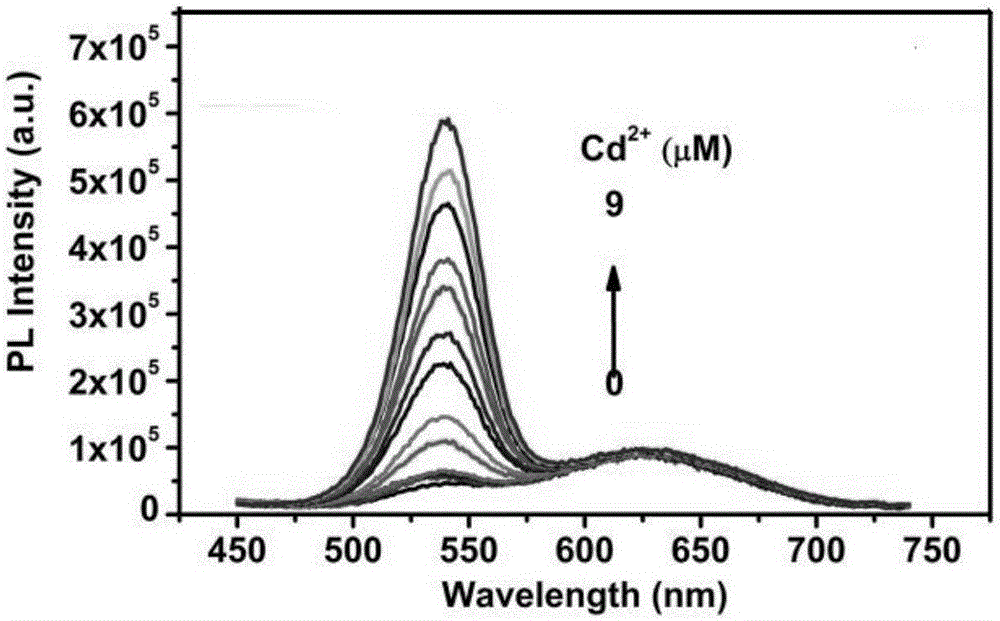Ratiometric fluorescent probe based on ion imprinting, preparation and application thereof
A ratiometric fluorescent probe and ion imprinting technology, which is applied in the direction of fluorescence/phosphorescence, luminescent materials, and material analysis through optical means, can solve the problems of unreported detection of cadmium ions, etc., and achieve rapid visual detection, convenience, excellent specificity, cheap effect
- Summary
- Abstract
- Description
- Claims
- Application Information
AI Technical Summary
Problems solved by technology
Method used
Image
Examples
Embodiment 1
[0036] 1. Preparation of red quantum dots
[0037] 0.2284g cadmium chloride (CdCl 2 2.5H 2 O) Add it to 500mL deionized water, pass nitrogen gas for 20min, then add 0.1mL mercaptopropionic acid, then adjust the pH to 11.00 with 1M aqueous sodium hydroxide solution, then continue to add 0.538g sodium citrate (containing crystal water), 0.0444g Sodium tellurite, 0.2g sodium borohydride, and finally heated to reflux. After refluxing for 8h, obtain a stable cadmium telluride quantum dot aqueous solution (i.e. red quantum dot solution) that emits red fluorescent mercaptopropionic acid, the emission peak is at 628 nanometers, and the concentration is 4.3 × 10 -6 mol / L.
[0038] Take 4mL of the synthesized red quantum dot solution, add 4mL of absolute ethanol, let it settle, centrifuge, wash the precipitate with absolute ethanol 1-2 times, and obtain 3 mg of cadmium telluride red quantum dots.
[0039] 2. Silica nanoparticles embedded with red quantum dots
[0040] Take 1mg of r...
Embodiment 2
[0044] 1. Preparation of red quantum dots
[0045] 0.2284g cadmium chloride (CdCl 2 2.5H 2 O) Add it to 500mL deionized water, pass nitrogen gas for 20min, then add 0.1mL mercaptopropionic acid, then adjust the pH to 11.00 with 1M aqueous sodium hydroxide solution, then continue to add 0.538g sodium citrate (containing crystal water), 0.0444g Sodium tellurite, 0.2g sodium borohydride, and finally heated to reflux. After refluxing for 8h, obtain a stable cadmium telluride quantum dot aqueous solution (i.e. red quantum dot solution) that emits red fluorescent mercaptopropionic acid, the emission peak is at 628 nanometers, and the concentration is 4.3 × 10 -6 mol / L.
[0046] Take 4mL of the synthesized red quantum dot solution, add 4mL of absolute ethanol, let it settle, centrifuge, wash the precipitate with absolute ethanol 1-2 times, and obtain 3 mg of cadmium telluride red quantum dots.
[0047] 2. Silica nanoparticles embedded with red quantum dots
[0048] Take 1mg of r...
Embodiment 3
[0052] 1. Preparation of red quantum dots
[0053] 0.4568g cadmium chloride (CdCl 2 2.5H 2 O) Add it to 500mL deionized water, pass nitrogen gas for 20min, then add 0.2mL mercaptopropionic acid, then adjust the pH to 11.00 with 1M aqueous sodium hydroxide solution, then continue to add 1.076g sodium citrate (containing crystal water), 0.0888g Sodium tellurite, 0.4g sodium borohydride, and finally heated to reflux. After refluxing for 8h, obtain a stable cadmium telluride quantum dot aqueous solution (i.e. red quantum dot solution) that emits red fluorescent mercaptopropionic acid, the emission peak is at 628 nanometers, and the concentration is 6.5 × 10 -6 mol / L.
[0054] Take 2mL of the synthesized red quantum dot solution, add 2mL of absolute ethanol, let it settle, centrifuge, wash the precipitate with absolute ethanol 1-2 times, and obtain 2.8 mg of cadmium telluride red quantum dots.
[0055] 2. Silica nanoparticles embedded with red quantum dots
[0056] Take 1mg of...
PUM
| Property | Measurement | Unit |
|---|---|---|
| particle diameter | aaaaa | aaaaa |
Abstract
Description
Claims
Application Information
 Login to View More
Login to View More - R&D
- Intellectual Property
- Life Sciences
- Materials
- Tech Scout
- Unparalleled Data Quality
- Higher Quality Content
- 60% Fewer Hallucinations
Browse by: Latest US Patents, China's latest patents, Technical Efficacy Thesaurus, Application Domain, Technology Topic, Popular Technical Reports.
© 2025 PatSnap. All rights reserved.Legal|Privacy policy|Modern Slavery Act Transparency Statement|Sitemap|About US| Contact US: help@patsnap.com



